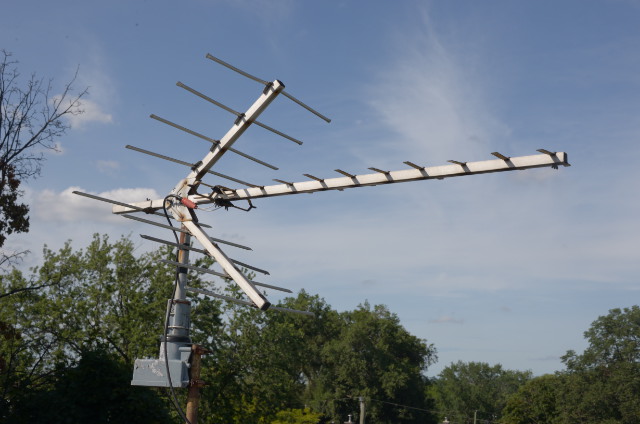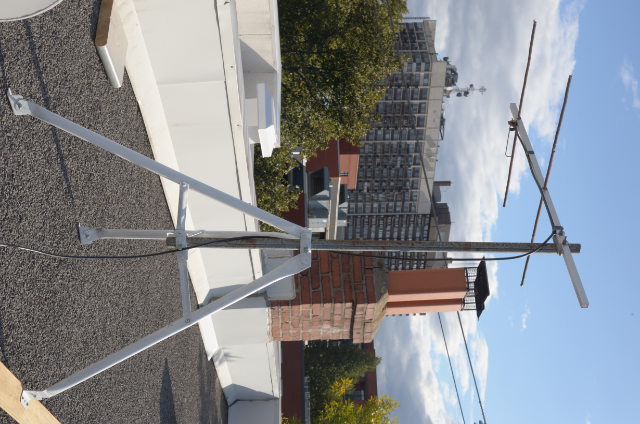
Introduction
I have carried out a few DTV antenna experiments over several years. The most successful results are summarized in this note. I hope that you will find it useful.
From my location (postal code H4B2S1) in central NDG, I receive all of the Montreal-area DTV channels. On VHF: WVNY-22 (7), CFTM-10 (11), CFCF-12 (12). On UHF: WPTZ-5 (14), CKMI-15 (15), WFFF-44 (16), CJNT-62 (17), CBFT-2 (19), WCAX-3 (20), CBMT-6 (21), CIVM-17 (26), CFTU-29 (29), CFHD-47 (31), WETK-33 (32), CFJP-35 (35), WCFE-57 (36). (Note that Channels 2-13 are VHF and 14-36 are UHF. Channels 37 and up are gone, they no longer exist.)
There are two numbers associated with a TV station. For example, CBMT-6 (21) started out in the 1950s on Channel 6. In the 2000s they were moved to Channel 21 for their new DTV transmitter. So they are not transmitting on Channel 6 anymore. But they chose to retain "Channel 6" as a name, so that people would not get confused. How confusing! This matters if you're buying an antenna, since CBMT is on UHF 21, not VHF 6.
If you do a scan with a DTV tuner it will find CBMT on Channel 21 but the tuner will also recognize and remember that 21 wants to pretend it is still "Channel 6". From then on, you will get CBMT (21) by pressing 6.
My UHF Antenna

I use a yagi/corner reflector with a rotor. I hacksawed it off the front end of an old VHF-UHF antenna, and threw away the VHF part. The antenna is about 5 ft above the roof and 30 ft above the ground. The gain is about 10 dB.
VHF, and WVNY-22

I made a 2-element yagi that is cut for Ch. 7 and points towards VT. The gain is 6 dB and the front/back ratio is 8.5 dB. Reception is excellent, but only when RFI is absent. More details are provided here.
VHF local channels CFTM-10 and CFCF-12 are strong and easily come in on the yagi, even though it's the wrong kind of antenna (Ch. 7 yagi) that is pointed in the wrong direction (towards VT).
The UHF antenna plus VHF yagi feed into a VHF/UHF coupler. That way only one downlead to the TV is needed.
Multipath
Large buildings can cause multiple reflections of the signal. The TV will pick up the desired signal, but also some weaker and delayed replicas. This effect is called multipath (and caused "ghosts" on analog TV). Multipath can cause digital TV reception to break up, even if the signal is strong.
When multipath is present, moving the antenna a small distance, less than a wavelength, can have a huge effect. The signal can be either enhanced or reduced. Therefore, movement can be used not only to enhance a desired signal, but also to suppress undesired interference. Sometimes, moving an antenna just 10cm can greatly improve reception.
RFI
Radio-frequency interference (RFI) can kill your TV signal dead. Interference sources include: LED lights, motors, laptop and phone chargers, computer video cards, coffee machines, automobile remotes, microwave ovens, cracked power line insulators, damaged cable TV lines, cell towers. If the interference has multipath, you might be able to get rid of it by slightly moving the antenna a few centimeters.
An offending appliance could be in your house or elsewhere, maybe some 20 meters away. Less often, it could be 1-2 km away. A telltale symptom is regularity. The problem might happen, for example, when someone goes into their kitchen every evening, turns on a certain light, and makes tea. Try unpluging your appliances one by one (unplug, not just turn off) and maybe even ask your neighbors to try the same. Turning off circuit breakers one by one is the quickest way to narrow things down. If that does not work, then you need to do direction finding. Professionals do this with a portable receiver, usually a spectrum analyzer, and they have a good understanding of antennas and their directional properties.
If you find the emitter in your house or a neighbor's house, the first step is to contact the manufacturer and tell them about the problem with their product. They are usually quite responsive. Typical remedies include common-mode RF chokes and lowpass power line filters. If you reached a dead end and cannot find the emitter, it may be time to call in the federal government agency ISED. It has the mandate to investigate and mitigate RFI. They have the technical expertise to do direction finding. But remember that reporting your detailed observations will be important. A vague complaint will probably go nowhere and waste people's time. They also have the full legal authority to investigate suspected and uncooperative premises. To learn more about technical and legal aspects of RFI, I recommend the ARRL RFI Book.
Signal Strength
"Signal strength meter" is the wrong name for that thing on your tuner. It is really measuring the signal-to-noise ratio (SNR). You need about a 20 dB SNR to get a DTV tuner to lock. That is pretty high.
About amplifier noise: If the SNR at the antenna is inadequate, adding a mast-mounted preamp will be useless. The preamp will boost the noise just as much as the signal. But if you have an adequate SNR at the antenna and a very long run of coax, a preamp will help overcome the coax loss.
Noise sources: The following are considererd to be noise. (a) Weak signal, (b) multipath (c) co-channel interference (d) adjacent-channel interference, (e) preamp intermodulation distortion (f) RFI from from electronics in your house, your neighborhood, or even further.
With analog TV these problems were easy to diagnose as snow, ghosts, a venetian-blind picture, or intermod/adjacent channels. With DTV you are in the dark-- it can take a lot of experimentation to figure out which of these effects is the source of your reception problem. If you have a spectrum analyzer, you might diagnose some of these problems. The spectrum should have a flat power level over the 6 MHz channel bandwidth. If multipath is present, there will be peaks and dips in the spectrum. If there is RFI, it might show up as spikes or a broad band of noise.
Some Recommendations
If I were not an experimenter, I would likely be fine with one antenna, an off-the-shelf VHF/UHF combo and rotor. Channel Master, Winegard and others are all pretty good. Typical gains are in the range of 10 dB UHF and 6 dB VHF.
Unfortunately, I cannot guarantee what might work in your particular situation. But, I can recommend the online tools www.tvfool.com or www.rabbitears.info or www.fcc.gov to get an estimate of what channels you might receive.
The most important factor by far is the antenna's location. As a rule, keep it at least 5 ft above the average rooftop height in your area. Have a clear line of sight between you and the transmitter. My location is better than average, with unobstructed paths toward Mt. Royal and Mt. Mansfield.
Many people think that a high gain antenna is the best. This is not necessarily true. A low gain antenna has a broad beam, so you don't have to keep fussing with a rotor when surfing channels. The downside of lower gain is that the signal is weaker, and there can be a higher susceptibility to intererference and/or multipath.
Some people combine two antennas pointing in different directions, using a splitter in reverse. Since the combined pair is less directional, the gain is reduced. Also, a splitter causes 3 dB of loss.
Your digital TV tuner is full of software and there will be bugs. If you stop receiving a signal, try a rescan and a reboot! Unplug it from the wall, wait a few minutes, then plug it back in.
Buying Stuff
You can buy antennas locally from Raybel Electronique in Montreal, or Mastervox in Longueuil. These people can help you buy all the right parts. Raybel sells the more exotic yagi antennas, made by Wade. There is a huge store, Radioworld in Toronto.
Summary
6 dB VHF, 10 dB UHF seems to be more than enough gain. Most antennas, VHF/UHF combo or separate, should be fine --but they should be outdoors, at least 5 ft above the average rooftop height. Getting WVNY-22 can be harder, probably because of RFI from electronic devices.